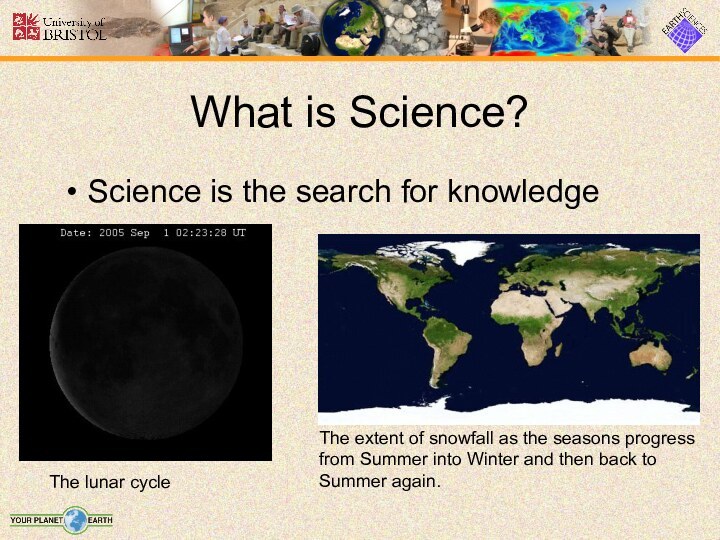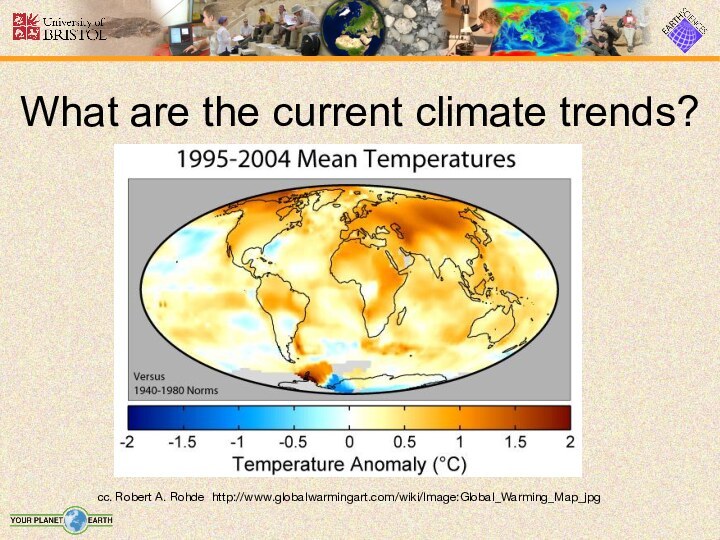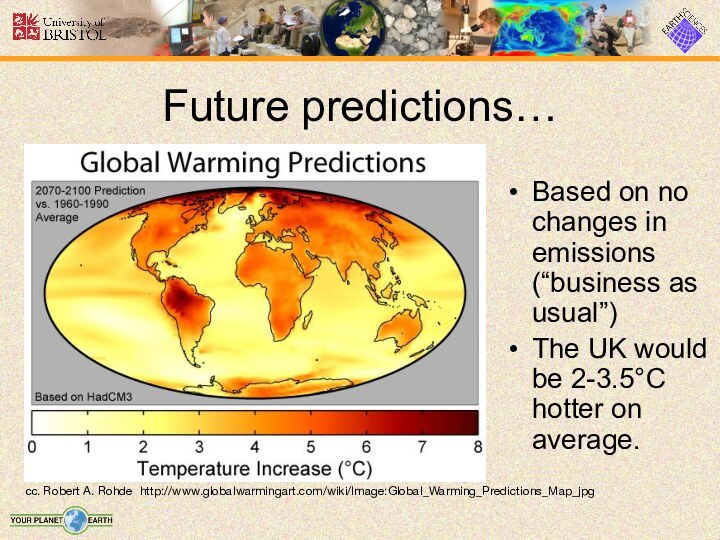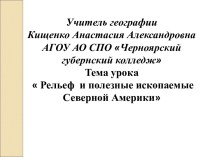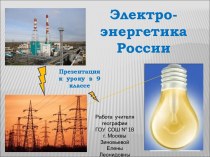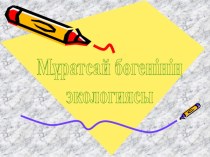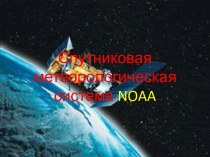Слайд 2
Contents
1 Definition
2 Climate classification
3 Record
3.1 Modern
3.2 Paleoclimatology
4 Climate change
4.1 Climate models
5 References
Слайд 3
What is Climate?
Climate =
the average and variations of weather over a long
period of time (~30 years) but other periods may be used depending on the purpose. Climate also includes statistics other than the average, such as the magnitudes of day-to-day or year-to-year variations.
Therefore, climate is “the average and variations of weather over long periods of time”.
Above: Global average for atmospheric water vapor.
Слайд 4
The Intergovernmental Panel on Climate Change (IPCC) glossary
definition is as follows:
Climate in a narrow sense is
usually defined as the "average weather," or more rigorously, as the statistical description in terms of the mean and variability of relevant quantities over a period ranging from months to thousands or millions of years. The classical period is 30 years, as defined by the World Meteorological Organization (WMO). These quantities are most often surface variables such as temperature, precipitation, and wind. Climate in a wider sense is the state, including a statistical description, of the climate system.[5]
Слайд 5
The difference between climate and weather is usefully
summarized by the popular phrase "Climate is what you
expect, weather is what you get."[6]
Слайд 6
Climate classification
There are several ways to classify climates into similar
regimes. Originally, climes were defined in Ancient Greece to describe the weather depending
upon a location's latitude. Modern climate classification methods can be broadly divided into genetic methods, which focus on the causes of climate, and empiric methods, which focus on the effects of climate. Examples of genetic classification include methods based on the relative frequency of different air mass types or locations within synoptic weather disturbances. Examples of empiric classifications include climate zones defined by plant hardiness,[10] evapotranspiration,[11] or more generally theKöppen climate classification which was originally designed to identify the climates associated with certain biomes
Слайд 7
Bergeron and Spatial Synoptic
The simplest classification is that
involving air masses. The Bergeron classification is the most
widely accepted form of air mass classification. Based upon the Bergeron classification scheme is the Spatial Synoptic Classification system (SSC). There are six categories within the SSC scheme: Dry Polar (similar to continental polar), Dry Moderate (similar to maritime superior), Dry Tropical (similar to continental tropical), Moist Polar (similar to maritime polar), Moist Moderate (a hybrid between maritime polar and maritime tropical), and Moist Tropical (similar to maritime tropical, maritime monsoon, or maritime equatorial).[14]
Слайд 8
The Köppen Climate Classification System is the most
widely used for classifying the world's climates. Most classification
systems used today are based on the one introduced in 1900 by the Russian-German climatologist Wladimir Köppen. Köppen divided the Earth's surface into climatic regions that generally coincided with world patterns of vegetation and soils.
Слайд 9
Köppen climate classification
The Köppen system recognizes five major
climate types based on the annual and monthly averages
of temperature and precipitation. Each type is designated by a capital letter. A - Moist Tropical Climates are known for their high temperatures year round and for their large amount of year round rain. B - Dry Climates are characterized by little rain and a huge daily temperature range. Two subgroups, S - semiarid or steppe, and W - arid or desert, are used with the B climates. C - In Humid Middle Latitude Climates land/water differences play a large part. These climates have warm, dry summers and cool, wet winters. D - Continental Climates can be found in the interior regions of large land masses. Total precipitation is not very high and seasonal temperatures vary widely. E - Cold Climates describe this climate type perfectly.
Слайд 11
Global Climate Change
Climate Change, Global Warming…
…Shilina Anastasia
Logunov Andrew
9B
Слайд 12
What is Weather?
Weather = all natural phenonmena within
the atmosphere at a given time (hours to days)
Слайд 13
What is Science?
Science is the search for knowledge
The
lunar cycle
The extent of snowfall as the seasons progress
from Summer into Winter and then back to Summer again.
Слайд 14
What is Climate Change?
Records change over decades to
millions of years
Слайд 15
The Earth has many different systems that interact
with each other in different ways.
Land
Oceans
Atmosphere
Biosphere
Ice
The Climate System
Слайд 16
Modern Climate Systems
Atmospheric circulation
Sunlight
Слайд 17
Modern Climate Systems
Ocean circulation
The Great Ocean Conveyor
Sinking cool
water, rising warm water and wind help to form
global ocean current systems.
Слайд 18
What is the Greenhouse Effect?
cc. Robert A. Rohde
(Global Warming Art)
cc. Robert A. Rohde (Global Warming Art)
The
temperature of the Earth depends on the amount of energy we receive from the sun versus the amount of energy lost back out to space.
Слайд 20
What are the current climate trends?
cc. Robert A.
Rohde http://www.globalwarmingart.com/wiki/Image:Global_Warming_Map_jpg
Слайд 21
Future predictions…
Based on no changes in emissions (“business
as usual”)
The UK would be 2-3.5°C hotter on average.
cc.
Robert A. Rohde http://www.globalwarmingart.com/wiki/Image:Global_Warming_Predictions_Map_jpg
Слайд 22
The way to solve the problem.
Recycle
Turn off lights
Low
energy light bulbs
Shorter showers
Recycle «grey»water
Install solar panels
Walk or ride
instead of taking a vehicle












